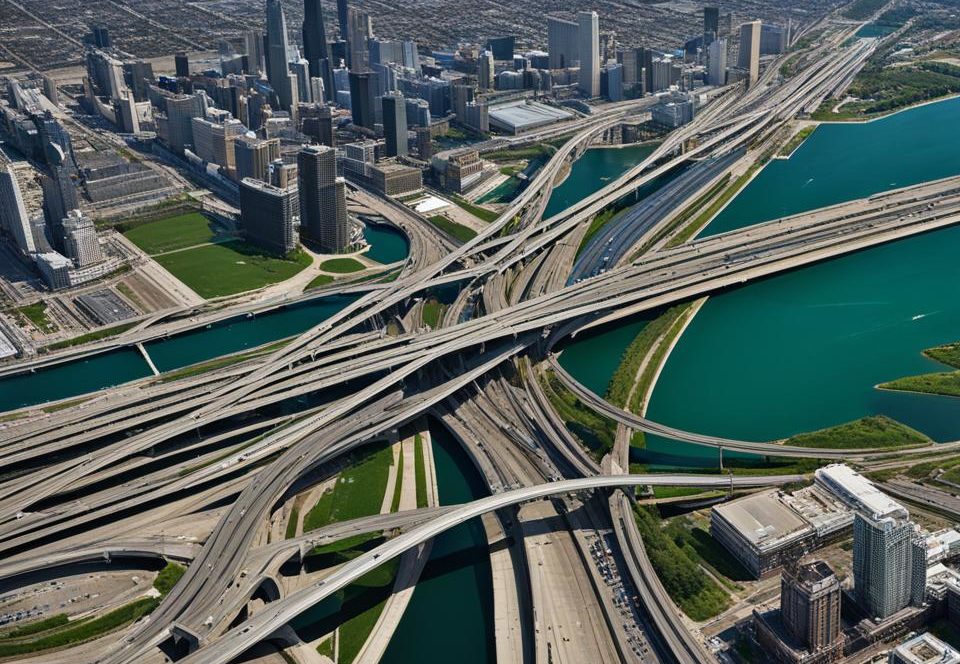Welcome to our article on the current condition of Chicago’s transportation infrastructure and the challenges it is facing. In this section, we will explore why Chicago’s transportation infrastructure is in its current state and provide recommendations for improvement.
Chicago, known for its bustling city life and diverse population, is experiencing significant strain on its transportation system. With the growing population and the emergence of new mobility innovations, such as ride-hailing services and autonomous vehicles, the existing infrastructure is struggling to keep up with the demands.
The City of Chicago’s Transportation and Mobility Task Force report highlights the need for reinvention and modernization of the transportation landscape to address challenges like global climate change, urban equity, and economic opportunity. The report has formulated a set of recommendations that aim to streamline governance, improve data sharing, support infrastructure investments, encourage mode shift, promote environmental sustainability, and prepare for connected and automated vehicles.
Implementing these recommendations, however, requires substantial funding and coordinated efforts from various stakeholders. Let’s delve deeper into the challenges facing Chicago’s transportation infrastructure and explore the recommendations that could pave the way for a reliable and efficient multi-modal network.
Key Takeaways:
- Chicago’s transportation infrastructure is facing challenges due to the growing population and the rise of new mobility innovations.
- The Transportation and Mobility Task Force report recommends streamlining governance, improving data sharing, supporting infrastructure investments, encouraging mode shift, promoting sustainability, and preparing for connected and automated vehicles.
- Funding shortage, aging infrastructure, and competition from private mobility services are major challenges faced by Chicago’s transportation infrastructure.
Challenges Facing Chicago’s Transportation Infrastructure
Chicago’s transportation infrastructure is currently grappling with several challenges that hinder its functionality and efficiency. One of the primary obstacles is the funding shortage that the city’s public transit system is facing. The CTA, Metra, and Pace are in desperate need of capital investments to address repair backlog and modernization requirements. Insufficient funding has resulted in the deterioration of assets and a growing repair backlog, which compromises the system’s reliability and quality of service.
Another significant challenge is the aging infrastructure in Chicago. As the city’s transportation system ages, it becomes increasingly challenging to maintain and upgrade the necessary infrastructure to keep up with the growing demands of the population. This infrastructure’s deteriorating condition further exacerbates the strain on the transportation network and limits its capacity to cater to the residents’ needs.
Furthermore, emerging private mobility services, such as ride-hailing companies like Uber and Lyft, present competition for Chicago’s transportation infrastructure. These services offer convenient and on-demand transportation options, potentially leading to a decline in transit ridership and service quality. This competition poses a challenge for the city’s public transit system to attract and retain riders, especially in areas where these private services are readily available.
Funding Shortage and Aging Infrastructure Chart
| Challenges | Impact |
|---|---|
| Funding Shortage | ✕ Financial constraints for infrastructure repairs and upgrades ✕ Increased repair backlog ✕ Compromised reliability and quality of service |
| Aging Infrastructure | ✕ Difficulty in maintaining and upgrading infrastructure ✕ Strained capacity and functionality of the transportation network ✕ Inability to cater to growing demands |
In summary, the challenges facing Chicago’s transportation infrastructure include a funding shortage, aging infrastructure, and competition from private mobility services. Addressing these challenges is crucial to ensure a reliable and efficient transportation system that meets the needs of Chicago’s residents and enhances the city’s overall mobility.
Recommendations for Improving Chicago’s Transportation Infrastructure
To address the challenges facing Chicago’s transportation infrastructure, the City’s Transportation and Mobility Task Force has outlined a series of recommendations. These recommendations aim to modernize and expand Chicago’s transportation system, creating a reliable and accessible network for residents, visitors, and businesses.
One key recommendation is to streamline governance and management of the transportation system. This includes improving coordination between city departments and private sectors, ensuring a more efficient and integrated approach to transportation planning and implementation.
Another important recommendation is to improve data sharing. By establishing uniform and secure data sharing requirements between public and private entities, decision-making and planning can be enhanced. This will lead to more informed and effective transportation solutions for the city.
Supporting infrastructure investments is also highlighted as a vital step. By increasing funding for the public transit system and addressing state-of-good-repair needs, Chicago can maintain the quality and reliability of its transportation assets, ensuring a smooth and efficient experience for commuters.
The Task Force also emphasizes the need to encourage mode shift. This involves promoting alternative modes of transportation such as walking, cycling, and public transit, in order to reduce congestion and improve overall sustainability.
In line with promoting sustainability, the report recommends building a multi-modal transportation system that prioritizes environmental health. This includes investing in infrastructure that reduces emissions and supports cleaner modes of transportation, as well as incorporating green spaces and pedestrian-friendly designs.
Lastly, the Task Force recognizes the necessity of preparing for connected and automated vehicles. By conducting necessary studies and infrastructure planning, Chicago can ensure a seamless integration of this emerging technology into its transportation system.
Overall, these recommendations aim to create a transportation system that is safe, equitable, efficient, and sustainable for all users in Chicago. By implementing these measures and securing the necessary funding, the city can lay the foundation for a modern and forward-thinking transportation infrastructure.

